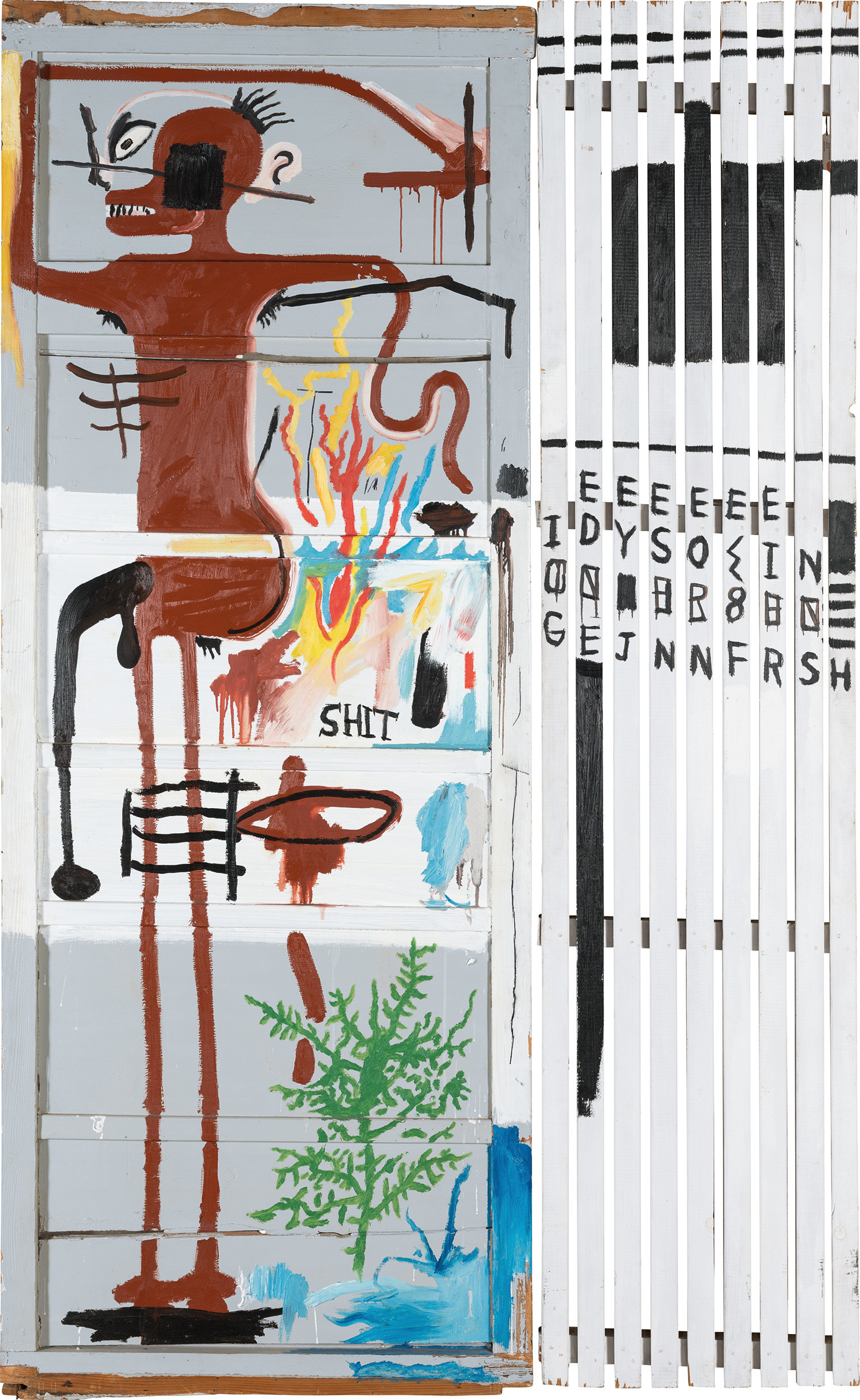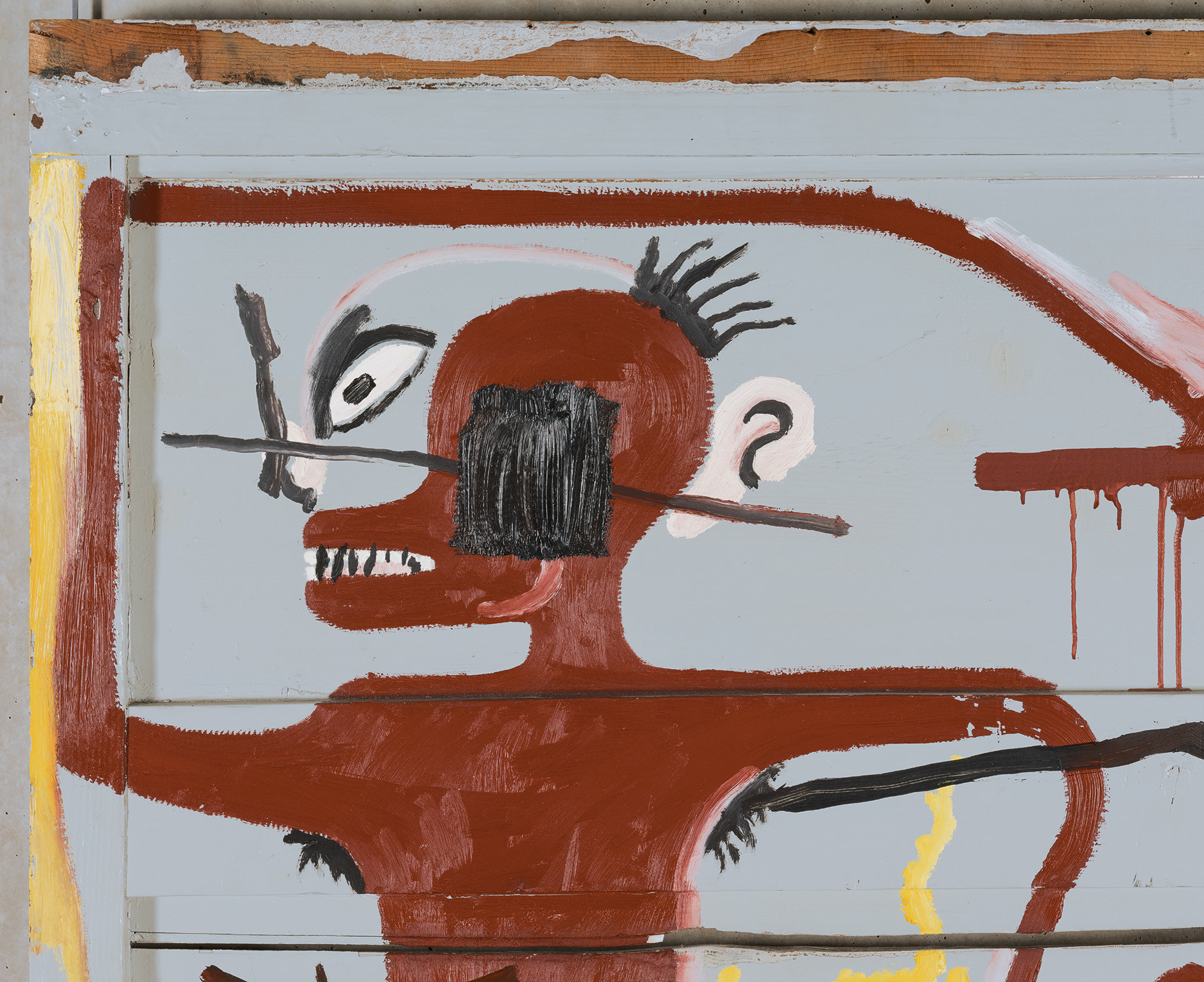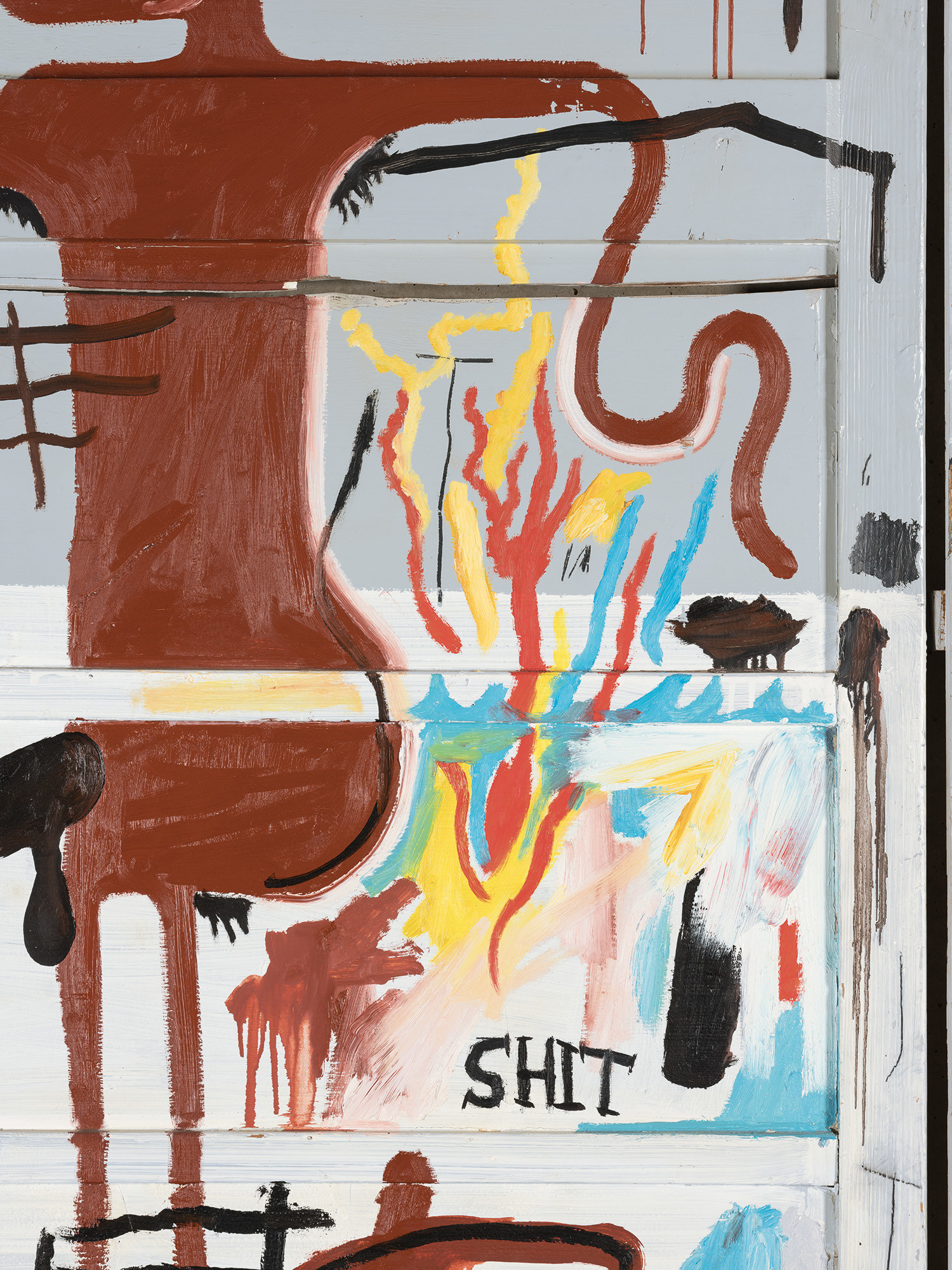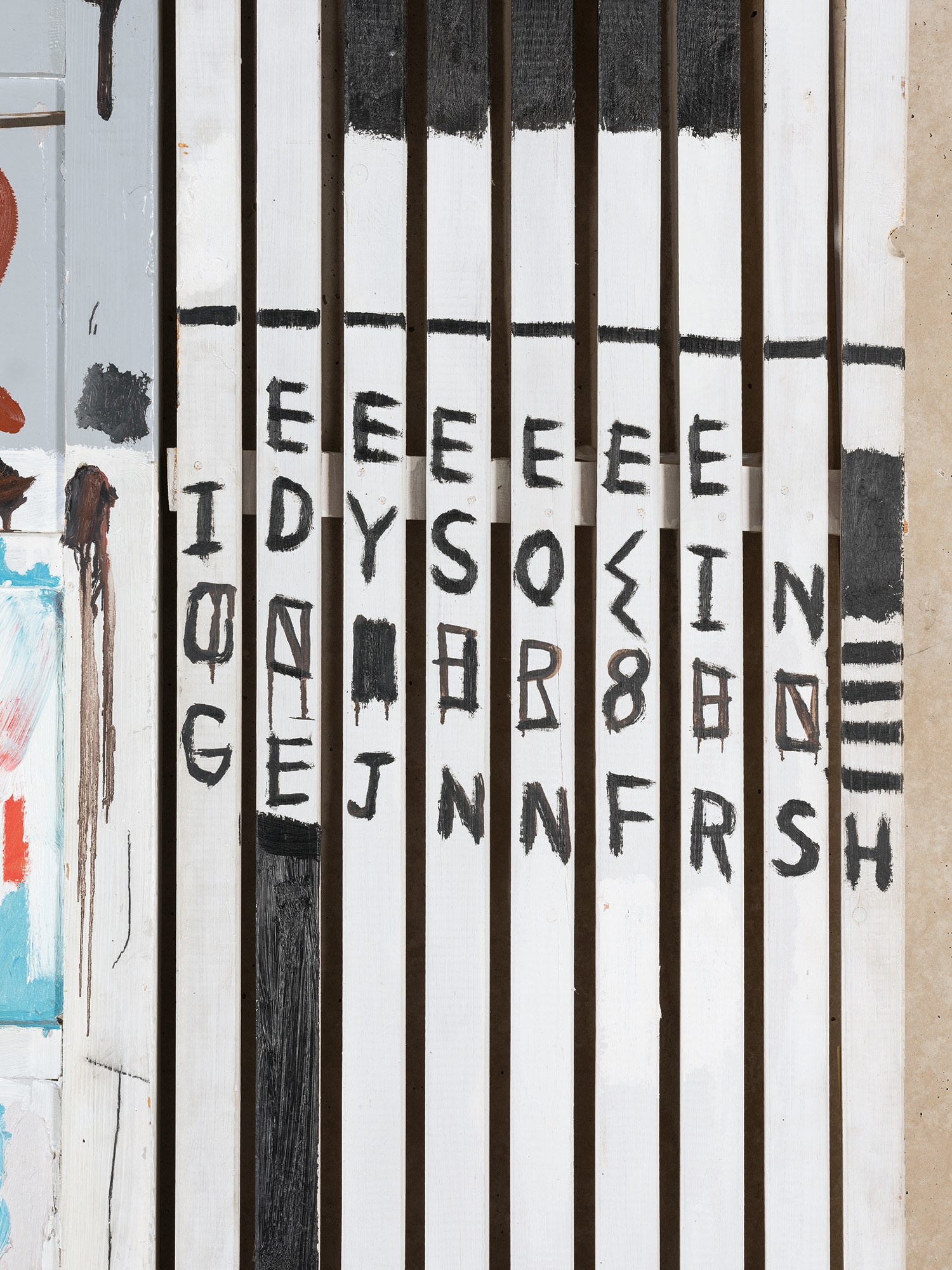







8Ο◆✱
Jean-Michel Basquiat
Thermopolae
Full-Cataloguing
Jean-Michel Basquiat, dubbed “the radiant child” by the American art critic Rene Ricard, was an extraordinarily gifted neo-expressionist painter with an ability to shock, inspire and get under the skin of his viewers past and present (Rene Ricard, ‘The Radiant Child’, Artforum, December 1981). Self-taught, with a restless and prolific mind, he developed a unique visual vocabulary drawn from his Haitian and Puerto Rican heritage, pop culture, history, poetry and his enduring fascination for Abstract Expressionist art. His intellectual curiosity led to a defiant insistence on portraying challenging themes, relying on layers of meaning enfolded within a complexity of symbols to convey incisive social commentary and speak to dichotomies such as wealth and poverty, integration and segregation, and the inner versus outer experience.
The Battle of Thermopolae
Thermopolae, created in the later years of Basquiat’s brief but intense artistic career, is in many ways an anti-painting, a subversive allegorical masterpiece that draws on the same narratives and Classical mythological roots of the elevated Western historical genre, but upturns accepted moral, spiritual, political meanings to speak passionately about life, death, love, virtue, and justice in postwar America, particularly amongst the Afro-American community and other marginalised bodies. Through Thermopolae and his protagonist the anti-warrior, Basquiat gleefully dismantles the cultural tropes and iconography of “the Other”, a fundamentally reductive narrative of weakness and deficiency concerning non-Western peoples, which emerged predominantly from Western colonial thinking as a means of supporting established hegemonies and hierarchies of domination.
Thermopolae is a reference to the Battle of Thermopylae in 480 BC, fought between the doomed Greeks and invading Persians at the narrow coastal pass of Thermopylae (in Latin, "the hot gates"). In the hands of Basquiat’s wordplay (a precocious child, Basquiat was fluent in English, French and Spanish by the age of 11), the title of the battle becomes bastardised - “a little heat”, rather than the most famous military last stand of Western civilisation.
Basquiat was fascinated by the power and vulnerability of marginalised bodies. Obsessed with anatomy since being gifted a copy of the famous medical and artistic treatise Gray’s Anatomy as a young child by his mother as he lay recovering in hospital after being hit by a car, Basquiat’s anti-hero, a naked, shitting, overly-endowed, dark-skinned savage-warrior waving a spear, manifests a visible skull, ribcage, sinew and spilling guts. He is the physical antithesis of his counterpart in Jacques-Louis David’s neoclassical (and notoriously homoerotic) masterpiece Leonidas at Thermopylae (1814). Sitting erect, with marble-like alabaster skin bathed in light and his eyes turned towards heaven, nude but for an embroidered cloak and elaborately feathered helmet, the Spartan King Leonidas epitomises the classical ideals of male virtue, beauty and heroic self-sacrificial courage. The phallic scabbard barely hiding his modesty, Leonidas wields a gleaming sword in one hand and a long dark spear in the other. In the same vein, the famous Greek Eurymedon vase depicts a terrified Persian archer submitting to sexual humiliation at the hands of his virile Greek captor. But in Thermopolae Basquiat’s protagonist is the undisputed aggressor, and the subversive masculinity of this so-called barbarian repudiates classical iconography with a compelling and savage force. Basquiat follows in the footsteps of artists such as Picasso who with his painting Les Demoiselles d'Avignon (1907) “replaced the benign ideal of the Classical nude with a new race of sexually armed and dangerous beings” (Holland Cotter, ‘When Picasso Changed His Tune’, The New York Times, 10 February 2011).
The artist-warrior
Thermopolae’s anti-hero sports dreadlocks remarkably similar to Basquiat’s own hairstyle, and on the adjoining panel can be seen the Greek letters "IDYSOΣIN", a syncopated version of ‘idiosyncrasy’, or outsider. Basquiat's paintings became a tool for introspection and for identifying with his experiences in the African American community of his time, whilst inserting himself into the role of his subjects became a way of honouring and acknowledging their experiences.
When read as a self-portrait, the burning bush and flames behind the protagonist’s back suddenly take on urgent meaning as well. The story of the burning bush, aflame but not consumed by the fire, is the story told in the Book of Exodus about the moment God charged Moses with freeing his people from slavery under the Egyptians. The bush is an acutely political rallying cry: a criticism of colonialism and support for class struggle.
Basquiat took this duty seriously, and Thermopolae revisits Basquiat’s Untitled (History of the Black People) (1983), which juxtaposes images of the Atlantic slave trade alongside images of the Egyptian slave trade centuries before. The Thermopolae warrior’s stark profile and frontal position of the torso allude to Egyptian figural representation, and consequently reclaiming Egyptian culture as fundamentally African “subverts the concept of ancient Egypt as the cradle of Western Civilisation" (Andrea Frohne, ‘Representing Jean-Michel Basquiat’ in Isidore Okpewho et al (eds.), The African Diaspora: African Origins and New World Identities, Indiana, 1999, pp. 439–451).
Using his paintings to also attack power structures and systems of institutionalised racism, the Irony of Negro Policeman (1981) depicts how African-Americans under the control of a predominantly Caucasian society become complicit with "institutionalised forms of whiteness and corrupt white regimes of power" (Andrea Frohne, ‘Representing Jean-Michel Basquiat’, pp. 439–451).
‘I don't think about art when I'm working. I try to think about life.’
Basquiat’s paintings were a ‘calculated improvisation’; like beat poets who composed their writing from shredded scraps, he remixed his materials and themes compulsively and instinctively, working on multiple projects at once in his studio using found materials, oilstick, crayons, spray paint, pencil and acrylic paints at the same time. When he couldn't afford canvases, he fashioned them out of discarded wood found on the street, and consequently Thermopolae is an ironic ‘diptych’ fashioned from a repurposed door and fence.
Fascinated by the power of the written word since the beginning of his career (from his graffiti days as SAMO, tagging a mixture of strange symbols and social commentary in the streets of Manhattan, to his experimental 1983 hip hop record ‘Beat Pop’, now referred to as the ‘Holy Grail’ of hip hop artists), Basquiat frequently encoded his paintings with slang and cryptic codes, spontaneously pulling together quotes and images from books kept open on his studio floor. The letters "FRSH" are overwritten on the third line and repeated at the end of the fourth line of the panel on the right. Taken from the line "we’re fresh out of the pack" in a 1982 rap by Grand Wizard Theodore & The Fantastic 5, it has become a word that epitomises the epic life and work of Basquiat, the original artist.
Jean-Michel Basquiat
American | B. 1960 D. 1988One of the most famous American artists of all time, Jean-Michel Basquiat first gained notoriety as a subversive graffiti-artist and street poet in the late 1970s. Operating under the pseudonym SAMO, he emblazoned the abandoned walls of the city with his unique blend of enigmatic symbols, icons and aphorisms. A voracious autodidact, by 1980, at 22-years of age, Basquiat began to direct his extraordinary talent towards painting and drawing. His powerful works brilliantly captured the zeitgeist of the 1980s New York underground scene and catapulted Basquiat on a dizzying meteoric ascent to international stardom that would only be put to a halt by his untimely death in 1988.
Basquiat's iconoclastic oeuvre revolves around the human figure. Exploiting the creative potential of free association and past experience, he created deeply personal, often autobiographical, images by drawing liberally from such disparate fields as urban street culture, music, poetry, Christian iconography, African-American and Aztec cultural histories and a broad range of art historical sources.